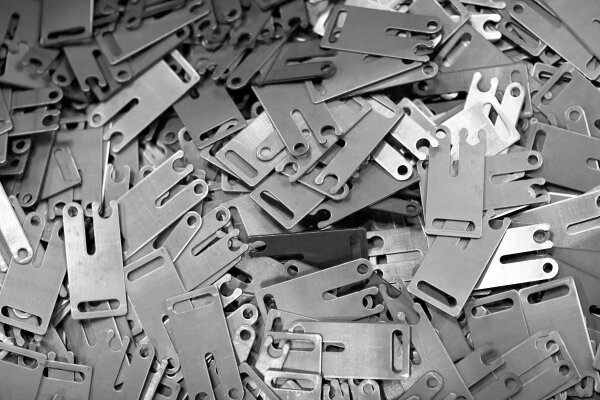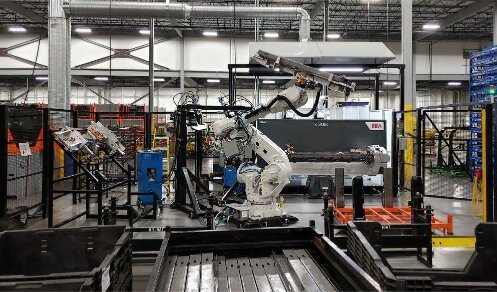Titanium staat bekend om zijn duurzaamheid en veelzijdigheid, waardoor het een populair materiaal is in de luchtvaart-, medische en auto-industrie. Het snijden van titanium brengt echter uitdagingen met zich mee. Door de hoge sterkte, hittebestendigheid en lage thermische geleidbaarheid is het moeilijker te snijden dan veel andere metalen. Fabrikanten moeten gespecialiseerde methoden gebruiken om precisie te garanderen en tegelijkertijd de integriteit van het materiaal te behouden.
Het snijden van titanium vereist specifieke methoden vanwege de hardheid en warmtegevoeligheid. Veelgebruikte technieken zijn lasersnijden, waterstraalsnijden, plasmasnijden, CNC-verspanen en elektrisch ontladen. Elke methode heeft voordelen en uitdagingen, dus het is belangrijk om de juiste te kiezen op basis van uw specifieke behoeften.
Het kiezen van de juiste snijmethode is essentieel voor fabrikanten die efficiëntie willen behouden en de kosten onder controle willen houden. Laten we eens kijken naar deze populaire snijprocessen voor titanium.
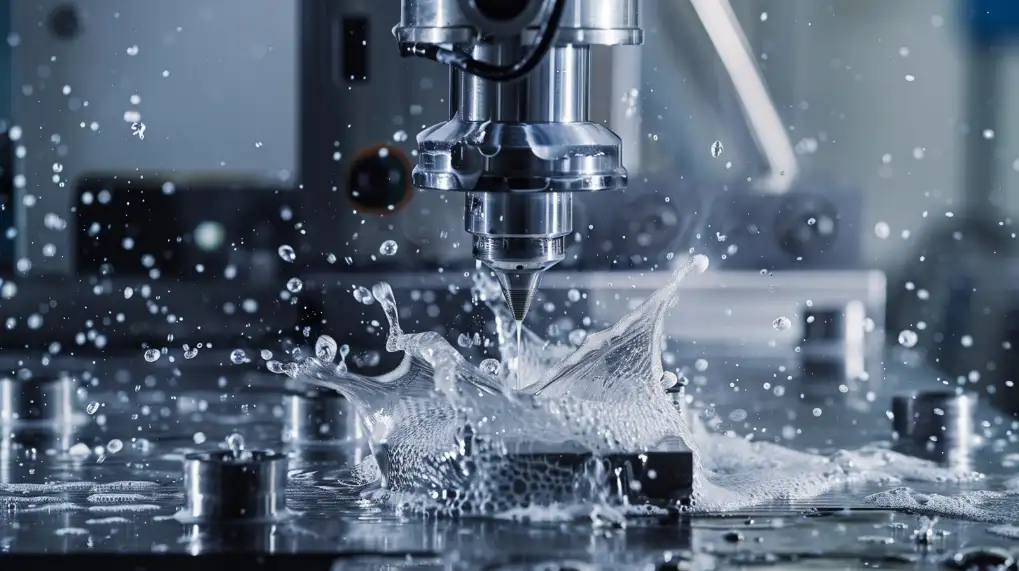
Wat is titanium snijden?
Titaan snijden is het vormen of wijzigen van titanium materiaal met behulp van verschillende technieken. Deze methoden omvatten lasersnijden, waterstraalsnijden en mechanisch snijden. De gekozen methode hangt af van de dikte en specifieke behoeften van het titanium stuk. Het belangrijkste doel is om zuivere, precieze sneden te maken zonder het materiaal te beschadigen.
Waarom is titanium zo moeilijk te snijden?
Titanium is moeilijk te snijden omdat het een sterk en hittegevoelig materiaal is. Het moet bij lage temperaturen worden gesneden om de beste resultaten te krijgen. Titanium absorbeert warmte snel, wat kan leiden tot kromtrekken of verkleuring als er niet zorgvuldig mee wordt omgegaan. De hardheid leidt ook tot snellere slijtage van het gereedschap. Dit vereist speciale gereedschappen en methoden om de nauwkeurigheid en precisie tijdens het snijden te behouden.
Eigenschappen van titanium
Titanium is een sterk, lichtgewicht metaal dat vaak wordt gebruikt in de ruimtevaart en de medische industrie. Het is bestand tegen corrosie en hoge temperaturen. Door zijn sterkte is het echter moeilijk te snijden.
De hardheid van titanium maakt het snijden ervan een uitdaging. Er is speciaal gereedschap voor nodig, omdat standaard snijmethodes snel slijten. Als het metaal niet goed wordt gesneden, kan het kromtrekken of barsten. Operators moeten de snijsnelheid en druk zorgvuldig regelen.
Titanium absorbeert ook gemakkelijk warmte. Deze warmte kan ervoor zorgen dat het materiaal vervormt tijdens het snijden. Methoden zoals waterstraalsnijden voorkomen dit probleem, terwijl lasersnijden een zorgvuldige warmtecontrole vereist om schade te voorkomen.
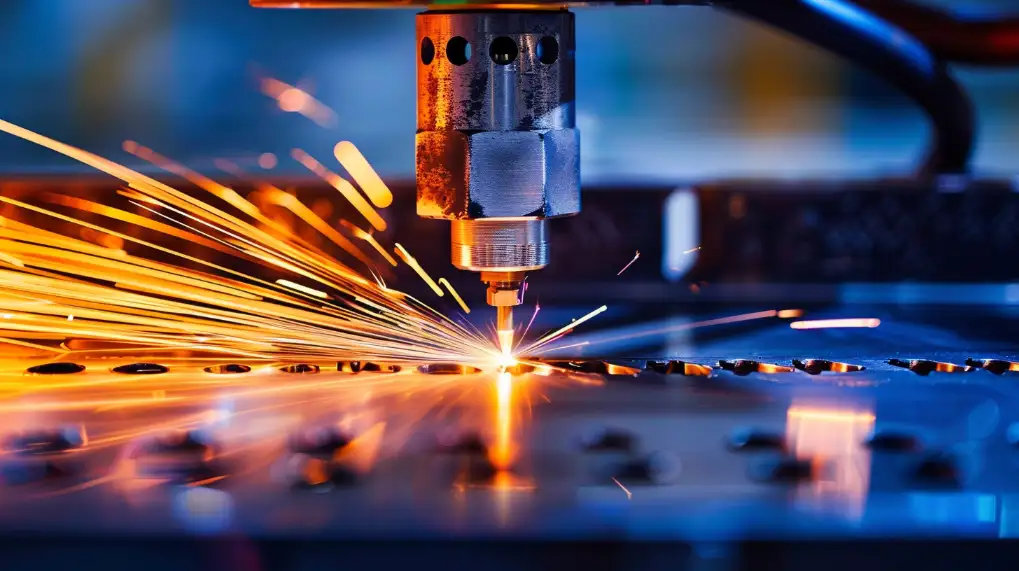
Hoe Titanium snijden? Gebruikelijke methoden
Het snijden van titanium vereist zorgvuldige aandacht vanwege de sterkte en warmtegevoeligheid. Hieronder beschrijf ik enkele veelgebruikte methoden om titanium te snijden.
Lasersnijden
Voordelen van lasersnijden Titanium
Lasersnijden zorgt voor precieze en schone randen. Het maakt gedetailleerde sneden en complexe vormen mogelijk met minimaal materiaalafval. De gefocuste laserstraal zorgt voor nauwkeurigheid, zelfs bij dikke titanium platen.
Uitdagingen en overwegingen bij lasersnijden
Voor het lasersnijden van titanium is zorgvuldige warmtebeheersing vereist. Titanium absorbeert gemakkelijk warmte, wat kan leiden tot kromtrekken of verkleuring als het niet onder controle wordt gehouden. Vaak worden speciale gassen zoals stikstof gebruikt om oxidatie te voorkomen, maar dit maakt het proces complexer.
Waterstraalsnijden
Precisie en zuiverheid van waterstraalsnijden
Waterstraalsnijden gebruikt water onder hoge druk, soms met schurende deeltjes, om door titanium te snijden. Deze methode zorgt voor precieze, schone sneden zonder warmte te genereren. Het is geweldig om vervorming in het materiaal te voorkomen, vooral bij dunnere stukken titanium.
Wanneer waterstraalsnijden voor titanium kiezen?
Waterstraalsnijden is ideaal voor titanium als er sprake is van hitteschade of als er gladde, schone randen nodig zijn. Het is uitstekend voor onderdelen met complexe vormen en nauwe toleranties, vooral bij dunnere titaniumplaten.
Plasmasnijden
Overzicht van plasmasnijden
Plasmasnijden maakt gebruik van een straal geïoniseerd gas (plasma) om door metalen zoals titanium te snijden. De hoge temperatuur van het plasma smelt het materiaal, dat vervolgens wordt weggeblazen. Plasmasnijden is sneller dan lasersnijden, maar over het algemeen minder nauwkeurig.
Beperkingen van plasmasnijden
Plasmasnijden werkt goed voor dikkere titanium platen, maar kan ruwe randen achterlaten. Er komt veel warmte vrij, wat de eigenschappen en afwerking van het materiaal aantast. Deze methode is niet ideaal voor precieze of ingewikkelde sneden, vooral bij dunner titanium.
CNC-bewerking
Overzicht van CNC-bewerking voor titanium
CNC-bewerking maakt gebruik van computergestuurde machines om titanium vorm te geven door materiaal te verwijderen. Het is zeer veelzijdig en maakt complexe vormen en nauwe toleranties mogelijk. CNC bewerking wordt gebruikt in zowel prototyping en massaproductie.
Voordelen en nauwkeurigheid van CNC verspanen
CNC-bewerking biedt een hoge precisie en herhaalbaarheid. Het kan gedetailleerde vormen maken zoals gaten, groeven en contouren. Deze methode is het meest geschikt voor projecten die fijne details en maatnauwkeurigheid vereisen in grotere hoeveelheden.
Veelgebruikte CNC-technieken voor het snijden van titanium
Veelgebruikte CNC-technieken zijn onder andere draaien, frezenen boren. Elke methode is geschikt voor verschillende toepassingen, afhankelijk van de grootte en vorm van het onderdeel. CNC-machines gebruiken verschillende gereedschappen om de hardheid van titanium te bewerken en de gewenste afwerking te bereiken.
Elektrische ontladingsbewerkingen (EDM)
Hoe EDM werkt voor titanium?
EDM maakt gebruik van elektrische vonken om kleine hoeveelheden titanium van het werkstuk te verwijderen. Een gecontroleerde elektrische ontlading tussen het gereedschap en het werkstuk erodeert het materiaal. Deze methode is zeer geschikt voor complexe vormen die moeilijk te bewerken zijn met traditionele methoden.
Belangrijkste voor- en nadelen van EDM voor titanium
EDM biedt een hoge precisie, waardoor het perfect is voor ingewikkelde ontwerpen en moeilijk bereikbare plaatsen. Het kan echter langzamer zijn dan andere methoden. Het proces genereert ook warmte die de materiaaleigenschappen kan beïnvloeden. EDM is het beste voor onderdelen met fijne details of hoge toleranties.
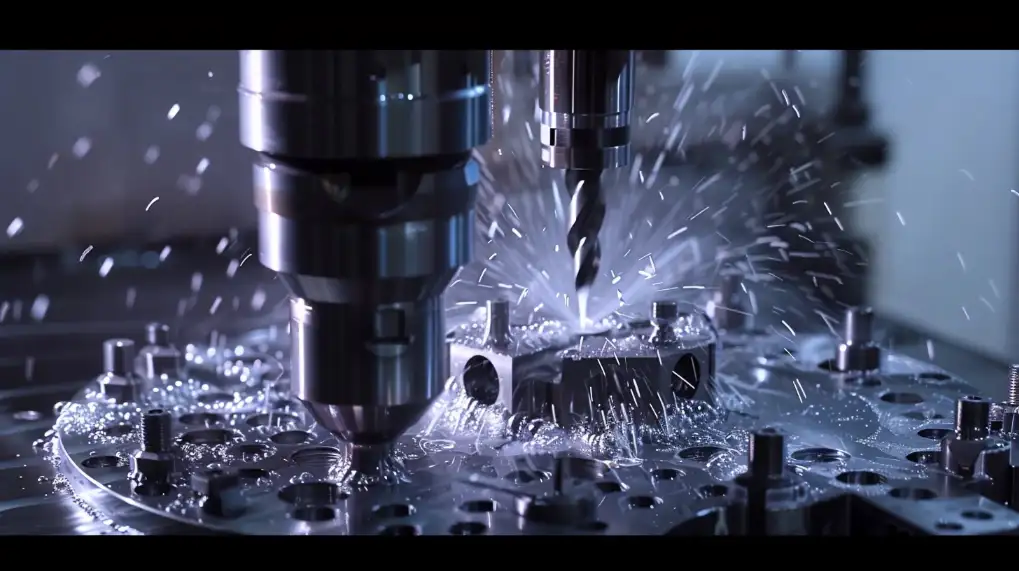
Factoren die het snijden van titanium beïnvloeden
Het snijden van titanium vereist een zorgvuldige afweging van verschillende factoren. Deze factoren beïnvloeden de keuze van de snijmethode en de kwaliteit van het eindresultaat. Laten we eens kijken naar de belangrijkste factoren die van invloed zijn op het snijden van titanium.
Materiaalklasse
Titanium is verkrijgbaar in verschillende kwaliteiten, elk met unieke eigenschappen die beïnvloeden hoe gemakkelijk het te snijden is. Titaanlegeringen van commerciële kwaliteit zijn bijvoorbeeld gemakkelijker te snijden dan geavanceerde legeringen zoals graad 5 (Ti-6Al-4V). De kwaliteit beïnvloedt het type gereedschap dat je nodig hebt, de snijsnelheid en de voedingssnelheid.
Snijsnelheid en voedingssnelheid
De snijsnelheid en doorvoersnelheid zijn cruciaal voor een goede snede. Te snel snijden kan overmatige hitte creëren, wat kan leiden tot kromtrekken van het materiaal of slijtage van het gereedschap. Een lagere snelheid in combinatie met de juiste voedingssnelheid resulteert in zachtere zaagsneden en vermindert de belasting op het gereedschap.
Gereedschapsselectie
Het kiezen van het juiste gereedschap is van vitaal belang bij het snijden van titanium. Vanwege de hardheid van titanium wordt meestal de voorkeur gegeven aan hardmetalen of gecoate gereedschappen. Deze gereedschappen blijven langer scherp en zijn beter bestand tegen slijtage. Scherp gereedschap vermindert ook de snijkrachten en helpt warmteontwikkeling aan de snijkant te voorkomen.
Warmtebeheer
Titanium absorbeert veel warmte tijdens het snijden. Als hier niet goed mee wordt omgegaan, kan dit leiden tot vervorming, verkleuring of defecten aan het gereedschap. Het gebruik van koelvloeistoffen of het kiezen van lagere snijsnelheden zijn effectieve manieren om de hitte onder controle te houden en betere resultaten te behalen.
Stijfheid van de machine
De stijfheid van de snijmachine is essentieel voor nauwkeurig snijden. Als de machine niet stijf genoeg is, kunnen er trillingen optreden die de kwaliteit van de snede beïnvloeden. Een stabiele machine met een hoge stijfheid zorgt voor een betere precisie en verlengt de levensduur van zowel de machine als het gereedschap.
Uitdagingen en oplossingen bij het snijden van titanium
Door zijn unieke eigenschappen brengt het snijden van titanium verschillende uitdagingen met zich mee. Inzicht in deze uitdagingen en hun oplossingen kan echter helpen om het snijproces te verbeteren en resultaten van hoge kwaliteit te garanderen.
Materiaalvervorming en vervorming
Titanium is gevoelig voor vervorming en vervorming tijdens het snijden, vooral als de warmte niet goed onder controle wordt gehouden. De hoge sterkte-gewichtsverhouding kan leiden tot kromtrekken als het snijproces niet zorgvuldig wordt uitgevoerd.
Oplossing:
Om vervorming te verminderen, kun je methoden met lage snelheden gebruiken, zoals waterstraalsnijden of lasersnijden. Waterstraalsnijden elimineert hitte, waardoor thermische vervorming wordt voorkomen. Klem- en opspantechnieken om het materiaal tijdens het snijden te stabiliseren kunnen ook buigen en kromtrekken helpen voorkomen.
De hoge kosten van titanium en het effect ervan op de snijkeuze
Titanium is duurder dan veel andere metalen, waardoor de productiekosten toenemen. De behoefte aan speciale gereedschappen en snijmethoden maakt de kosten nog hoger, vooral voor grote of precisieonderdelen.
Oplossing:
Fabrikanten moeten snijmethoden kiezen die een balans bieden tussen precisie en materiaalafval om de kosten te beheersen. Lasersnijden biedt bijvoorbeeld een hoge precisie met minimaal afval. Geavanceerde technieken zoals EDM kunnen ook de noodzaak voor nabewerking verminderen, wat op de lange termijn tijd en geld bespaart.
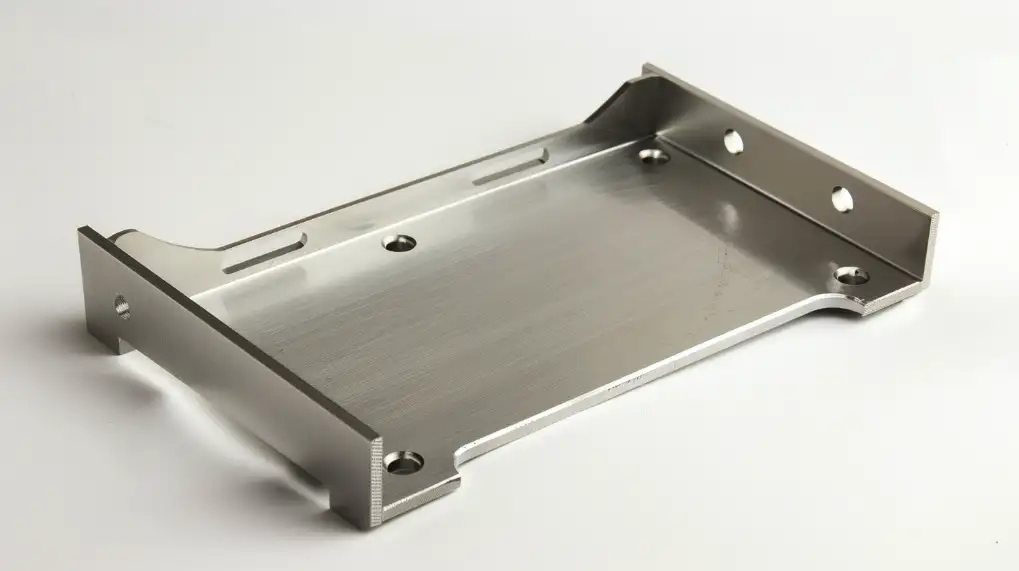
Toepassingen van titanium snijden
De sterkte, het lage gewicht en de corrosiebestendigheid van titanium maken het tot een cruciaal materiaal in veel industrieën. Hieronder staan enkele belangrijke toepassingen waarbij het snijden van titanium zorgt voor precisie, prestaties en duurzaamheid.
Ruimtevaartindustrie
Titanium wordt veel gebruikt in de lucht- en ruimtevaart voor onderdelen zoals turbinebladen, motoronderdelen en vliegtuigstructuren. Dankzij de verhouding tussen sterkte en gewicht is het bestand tegen extreme spanningen en hoge temperaturen.
Medische hulpmiddelen en implantaten
De unieke biocompatibiliteit van titanium maakt het van onschatbare waarde in de gezondheidszorg. Het wordt gebruikt voor implantaten, prothesen en chirurgische instrumenten.
Auto- en motorsport
In auto- en motorsporttoepassingen wordt titanium gebruikt voor onderdelen zoals uitlaatsystemen, kleppen en ophangingsonderdelen. De lichtgewicht en sterke eigenschappen verminderen het gewicht van het voertuig, waardoor de prestaties en brandstofefficiëntie verbeteren.
Mariene industrie
De corrosiebestendigheid van titanium maakt het ideaal voor toepassingen in de scheepvaart, zoals scheepsrompen, propellers en offshore-platforms die worden blootgesteld aan zeewater. De duurzaamheid en weerstand tegen het ruwe mariene milieu maken het tot een geliefd materiaal.
Conclusie
Vanwege de hardheid, warmtegevoeligheid en hoge kosten vereist het snijden van titanium speciale technieken. Het kiezen van het juiste snijproces is essentieel om nauwkeurige resultaten van hoge kwaliteit te bereiken en tegelijkertijd materiaalverspilling en slijtage van het gereedschap te minimaliseren.
Hulp nodig bij het snijden van titanium? Neem contact met ons op vandaag nog om je project te bespreken en de perfecte oplossing op maat te vinden!
Meer bronnen:
Veelzijdigheid van titanium - Bron: Titek
Integriteit van materiaal begrijpen - Bron: Thermofisher
Hey, ik ben Kevin Lee

De afgelopen 10 jaar heb ik me verdiept in verschillende vormen van plaatbewerking en ik deel hier de coole inzichten die ik heb opgedaan in verschillende werkplaatsen.
Neem contact op

Kevin Lee
Ik heb meer dan tien jaar professionele ervaring in plaatbewerking, gespecialiseerd in lasersnijden, buigen, lassen en oppervlaktebehandelingstechnieken. Als technisch directeur bij Shengen zet ik me in om complexe productie-uitdagingen op te lossen en innovatie en kwaliteit in elk project te stimuleren.

